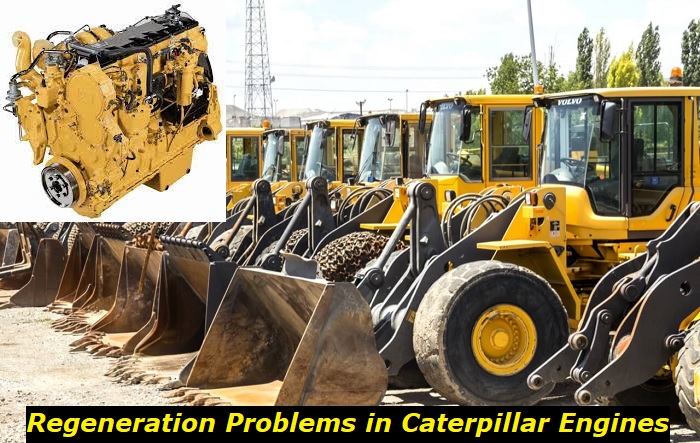Caterpillar Regeneration Problems: Common Reasons and Ways to Fix
The regeneration process in Caterpillar engines is crucial as it concerns the machine's performance, public health, and the environment. Regeneration is the procedure for cleaning Diesel Particulate Filter (DPF) in the engine. The DPF is a technology created to help reduce emissions from combustion engines. Over time the DPF can become clogged. Regeneration is how the caterpillar engine cleans a clogged or dirty DPF to run better and keep its exhaust levels within safe limits.
But just as the DPF can become clogged, the regeneration system in a Caterpillar engine can also fail. Thus, we want to examine some of the common causes of Caterpillar regeneration problems and their effect and discuss how you can fix them. But first, we will look into the DPF and Regeneration system in more detail in the next section.

Diesel Particulate Filter and Regeneration System
The diesel particulate filter in a Caterpillar removes Diesel Particulate Matter (DPM) from a diesel engine's exhaust. DPM are solid and gaseous particles produced by a diesel engine's exhaust. Included in the solid particles are chemicals that are capable of seriously damaging human health. High levels of DPM in the environment will pose a risk to public health. DPMs can cause respiratory illnesses like bronchitis and asthma.
There are regulations, including Tier 4 (the United States Environmental Protection Agency (EPA) and Environment Canada), Stage IIIB and Stage IV (European Union), and Step 4 (Japan), that seeks to limit the amount of DPM that gets into the atmosphere. DPFs are a crucial technology in meeting these standards. A DPF can reduce DPM emissions by up to 80%. They were first invented in 2000 by Peugeot. However, Caterpillar uses its proprietary technology: The Cat® Regeneration System (CRS).
A DPF is placed in diesel engines to trap DPM in the form of soot particles that pass through it from escaping the exhaust system of a diesel engine. A gauge shows the percentage of soot in the Caterpillar's DPF.
The regeneration system in a Caterpillar or any diesel engine is a system that burns off the trapped soot within the DPF. Regeneration in Caterpillar engines can occur in three ways, passive, active, and manual.
Passive regeneration occurs naturally when the engine's exhaust reaches very high temperatures around 350 degrees Celsius. Such high temperatures in the exhaust will burn off the soot trapped in the DPF. This type of regeneration will not occur outside of such high exhaust temperatures. Passive regeneration will not remove all the soot in your Caterpillar, which is why active regeneration is necessary.
Active regeneration occurs automatically and does not require operator input. Whenever the soot level in the DPF reaches a certain threshold, the Engine Control Unit (ECU) triggers regeneration without human input. There are sensors in the DPF to detect the soot level, which alert the engine control module when the soot builds up to a certain level and triggers regeneration. The engine's temperature increases to a level that can burn the soot in the DPF.
There is a light that indicates that active regeneration is in process. Active regen occurs when the machine is idle. So, when you start operating the machine, the active regen stops and looks for the best possible time to restart the process.
Manual regeneration is intentional or manually initiated by an operator of the Caterpillar so that the engine heats up to burn the soot. Caterpillar machines regenerate actively or in automatic mode. Still, in some situations, owners prefer the operator to control this process.
In manual mode, you initiate regeneration by pressing and holding the manual regeneration button for two seconds when the machine is idle. Ideally, you should trigger manual regeneration when soot levels cross the 15 percent mark.
As explained, both the DPF and Regeneration are very important. The DPF traps environmentally hazardous DPM and soot while Regeneration either passively, actively, or manually burns off the soot. The regeneration process helps the DPF maintain solid engine performance, increases its long-term durability, and reduces harmful emissions.
Common Reasons Regeneration Fails in Caterpillar Engine
Several things can prevent regeneration in a Caterpillar from taking place. They are listed and explained below.
1) Active Diagnostic Code
Automatic or passive regeneration will not occur in case of an active diagnostic, fault, or event code. Aftertreatment regeneration device fuel system, air system, or ignition system codes can prevent regeneration. In addition, exhaust gas recirculation codes can also stop the regeneration process. Also, engine error codes, including those related to emissions, temperature, turbo, and more, can prevent regeneration.
When these codes are active, regeneration in your Caterpillar will not occur. So, to get the regeneration system working again, fix the issues causing these codes.
2) Air Conditioning
Using the air conditioner in the cab of your Caterpillar machine can cause engine regeneration failure. Cooling fans and the engine lower the temperature when the air conditioner is on. The resulting cooling effect can affect the regeneration system, which requires high temperatures to work effectively.
3) Faulty DPF Pressure Sensors
The DPF pressure differential sensors are somewhere before and after the DPF. They perform the role of detecting the soot levels in the DPF by measuring pressure drops. If the soot levels reach the limit required for regeneration, the sensors alert the ECU by sending differential pressure readings, which then trigger the regeneration system. If the pressure sensors are faulty, they could fail to report readings to the ECU, which will not trigger regeneration.
Also, if faulty, the sensors may send incorrect readings to the ECU and trigger unnecessarily frequent regenerations. Temperature sensors may also impact regeneration in your Caterpillar's engine.
4) Electrical and Wiring Problems
The sensors in the DPF read soot levels and transmit the data to the ECU. Wires and other electrical problems are required for the sensors to transmit the data. In cases where the wiring or other electrical components like the fuse have issues, it will not be possible for correct readings from the pressure sensors to get to the ECM and other computer systems, causing regeneration failure.
Faulty wires will need replacement in the event of a wiring issue.
5) Hydrocarbon Doser and Inadequate fuel
For active or manual regeneration to work, fuel is sprayed into the exhaust to raise temperatures high enough to burn soot. The Hydrocarbon (HC) doser injects the fuel into the exhaust. If the HC doser is faulty or clogged, adequate fuel for Caterpillar regeneration will not get into the exhaust.
Low fuel levels will also hurt regeneration. Fuel injection is necessary for active and manual regeneration. Without enough of it, regeneration may fail.
6) Clogged DPF
With time, your Caterpillar's DPF can get clogged with soot. Recurring forced regenerations are a sign that the DPF is clogged. A clogged DPF indicates that the heat in the filter is not high enough to completely burn off the soot during regeneration. Pressure buildup in the DPF can cause it to crack without a fix.
7) Turbocharger Trouble
The turbocharger is essential for power generation and fuel efficiency in Caterpillar engines. The turbocharger uses exhaust gas to turn the turbine. After, the turbine spins the compressor. Then, the compressor forces air into the engine. This process allows the engine to burn more fuel and increase power production. In this way, the turbocharger helps build up heat to start regeneration. Thus, if the Caterpillar's turbocharger is faulty, regeneration will fail.
8) Software Bug
Active regeneration occurs when the ECU triggers regeneration after receiving information from the pressure sensors in the exhaust. Yet, a software bug can prevent the regeneration process from occurring when needed. Software bugs could come with the installed software in your Caterpillar or a software update may introduce them. Another software update would probably fix this issue. Contact a service center for assistance.
What Happens If Regeneration Fails?
If, for any reason, regeneration fails, the DPF will fill up with soot and force the engine power output to drop below the required operating condition and possibly shut down. Some other possible effects of a failed Caterpillar regeneration problem include the following:
- Engine misfire and damage
- DPF damage
- Check engine light and diagnostic codes
- Inefficient fuel consumption
- Low engine power
How To Fix Caterpillar Regeneration Problems
The first step in solving regeneration issues in a Caterpillar machine is diagnosis. Most modern Caterpillar equipment allows users to easily diagnose issues associated with regeneration via an onboard diagnostic tool. Outside of computerized diagnosis, if soot is coming out of the exhaust pipe, there is likely a problem with the regeneration system.
However, when it concerns repairing regeneration issues, fixing any one of the problems we outlined will require technical knowledge. Fixing any of these problems will not be particularly easy for casual users. As such, outside of recognizing and diagnosing the source of the regeneration problem in your Caterpillar, we recommend getting the assistance of an expert to fix the issue.
Once you detect this problem, get it to an authorized mechanic to fix it quickly to prevent it from spiraling into a bigger and possibly more expensive problem.
Nevertheless, below are some things you can do to prevent problems with the DPF and regeneration:
- If the check engine light comes on, you need to get the machine inspected by experts to fix any issues that could affect regeneration. It is also possible a failed regen is why the engine light is on. You can do a manual regeneration in this case to see if it fixes the error.
- Get your machine regularly inspected and maintained. The DPF should be cleaned regularly by a professional. The DPF should be vacuumed and cleaned out for Caterpillar trucks every 200000 to 250000 miles. Also, Performance for Caterpillar machines could be affected without the recommended maintenance after the 5000-hour mark.
- Three specific components require maintenance when it comes to regeneration, The DPF, spark plug, aftertreatment regeneration device, and the CRS fuel supply pump. Maintenance will help reduce the regeneration cycles, limit downtime due to damaged or worn parts, and improve fuel efficiency.
- Clean or replace spark plugs at the 5000-hour point. This is an easy and affordable way to guarantee that regeneration occurs in a precise manner.
- Replace the CRS to ensure the operator has the necessary pressure and flow for every regeneration at the 5000-hour point.
- Engine oil quality will also affect the longevity and effectiveness of the DPF and regeneration. Ensure you use high-quality engine oils.
Conclusion
In this guide, we set out to understand Caterpillar's regeneration problems. To do so, first, we explained the importance of the DPF and regeneration. Following that, we discussed some common causes of regeneration failures in Caterpillar machines. Then we looked at the effects they may have. Finally, we looked at how to fix them.
The regeneration system is crucial in Caterpillar's diesel engine because it helps maintain the machine's ability to safeguard the environment and public health and improve performance. You need to be on the lookout for common causes of Caterpillar regeneration problems and fix them before they become bigger issues. Fixing Caterpillar regeneration problems is not particularly easy, so we suggest you get the help of Caterpillar experts to correctly fix such problems.

Add comment